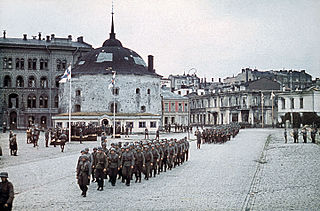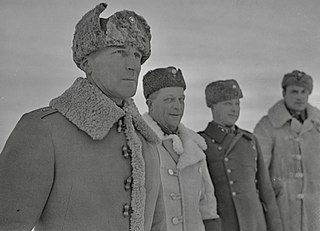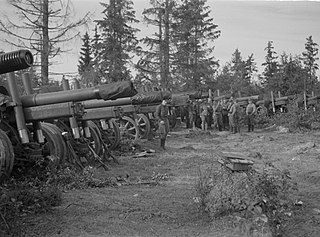
The Continuation War, also known as the Second Soviet-Finnish War, was a conflict fought by Finland and Nazi Germany against the Soviet Union during World War II. It began with a Finnish declaration of war and invasion on 25 June 1941 and ended on 19 September 1944 with the Moscow Armistice. The Soviet Union and Finland had previously fought the Winter War from 1939 to 1940, which ended with the Soviet failure to conquer Finland and the Moscow Peace Treaty. Numerous reasons have been proposed for the Finnish decision to invade, with regaining territory lost during the Winter War regarded as the most common. Other justifications for the conflict include Finnish President Risto Ryti's vision of a Greater Finland and Commander-in-Chief Carl Gustaf Emil Mannerheim's desire to annex East Karelia.

Paavo Juho Talvela was a Finnish general of the infantry, Knight of the Mannerheim Cross and a member of the Jäger movement. He participated in the Eastern Front of World War I, the Finnish Civil War, the Finnish Kinship Wars, the Winter War and the Continuation War.
The Army of Karelia was a Finnish army during the Continuation War.

The Vyborg–Petrozavodsk offensive or Karelian offensive was a strategic operation by the Soviet Leningrad and Karelian Fronts against Finland on the Karelian Isthmus and East Karelia fronts of the Continuation War, on the Eastern Front of World War II. The Soviet forces captured East Karelia and Vyborg/Viipuri. After that, however, the fighting reached a stalemate.

The Battle of Nietjärvi was part of the Continuation War between Finland and the Soviet Union, which occurred during World War II. The battle ended in a Finnish victory.

The Finnish invasion of the Karelian Isthmus refers to a military campaign carried out by Finland in 1941. It was part of what is commonly referred to as the Continuation War. Early in the war Finnish forces liberated the Karelian Isthmus. It had been ceded to the Soviet Union on 13 March 1940, in the Moscow Peace Treaty, which marked the end of the Winter War. Later, in the summer of 1944, the Soviet Union reconquered the southern part of the isthmus in the Vyborg–Petrozavodsk Offensive.

The Finnish invasion of East Karelia was a military campaign in 1941. It was part of the Continuation War. Finnish troops occupied East Karelia and held it until 1944. For over a month after the outbreak of the Continuation War, the Karelian Army reinforced and prepared to resume its earlier offensive while waiting for the recapture of the Karelian Isthmus. The Soviets had prepared fortifications and brought troops to the front. When encirclements on the western shore of Lake Ladoga were resolved, the Finnish 7th Division was transferred to the junction of VI and VII Corps.
The 8th Army was a field army of the Soviet Red Army during the Second World War.
7th Division was a Finnish Army division in the Continuation War. The division was formed Savo-Karjala military province from the men in Pohjois-Savo and Pohjois-Karjala civil guard districts.

Hannu Esa Hannuksela was a Finnish Major General during World War II.

The Battle of Tali–Ihantala was part of the Finnish-Soviet Continuation War (1941–1944), which occurred during World War II. The battle was fought between Finnish forces—using war materiel provided by Germany—and Soviet forces. To date, it is the largest battle in the history of the Nordic countries.

Antero Johannes Svensson was a Finnish major general, a member of the Jäger Movement and a recipient of the Mannerheim Cross. He participated in the Eastern Front of World War I as a volunteer of the 27th Royal Prussian Jäger Battalion, in the Finnish Civil War as a platoon and squadron commander, the Winter War as a brigade and division commander, and the Continuation War as a division and corps commander.
The 313th Rifle Division was a standard Red Army rifle division formed on July 15, 1941 in the Udmurt ASSR before being sent to the vicinity of Leningrad, first in the 7th Separate Army east of Lake Ladoga, and later in 32nd Army of Karelian Front, where it spent most of the war facing the Finnish Army in East Karelia. In consequence the division saw relatively uneventful service on this mostly quiet front until the summer of 1944, when it took part in the offensive that drove Finland out of the war. When this was accomplished, the division was redeployed to take the fight into Poland and then into the German heartland in the winter and spring of 1945. It ended the war north of Berlin after compiling a very distinguished record of service.

The Battle of Porlampi, also known as the Battle of Porlammi, was a military engagement fought between the Finnish Army and Red Army from 30 August to 1 September 1941 on the Karelian Isthmus. The battle was fought near the town of Porlampi during the second month of the Continuation War. The battle was a Finnish victory and effectively ended the reconquest of Karelia.
The I Corps refers to several short-lived units of the Finnish Army before and during the Continuation War. The longest-lived I Corps participated in both the Finnish invasion of Ladoga Karelia and the Finnish invasion of the Karelian Isthmus in 1941 before being disbanded in early 1942, before being re-designated V Corps.

Einar Nikolai Mäkinen was a Finnish lieutenant general and a member of the Jäger movement. He participated in the Eastern Front of World War I, the Finnish Civil War, the Winter War and the Continuation War. Before the Continuation War, he participated in negotiations with the Germans regarding plans for the war.
The II Corps was a unit of the Finnish Army during the Continuation War. During the war the corps participated in combat first northwest of Lake Ladoga and on the Karelian Isthmus before moving to the Povenets–Lake Segozero region by late 1941. During the Soviet offensive of 1944, the corps conducted a fighting retreat to the region of Ilomantsi, with parts of its forces participating in the subsequent Battle of Ilomantsi.
The VI Corps was a corps of the Finnish Army during the Continuation War of 1941 to 1944, where the Finnish Army fought alongside Germans against the Soviet Union. The unit was formed during a reorganization of other Finnish army corps on 29 June 1941, prior to the start of Finnish offensive operations on the night of 9–10 July.
The VII Corps was a corps of the Finnish Army during the Continuation War of 1941 to 1944, where the Finnish Army fought alongside Germans against the Soviet Union. Under command of Major General Woldemar Hägglund, it took part in the Finnish invasions of Ladoga Karelia and East Karelia, including the capture of Petrozavodsk. During its existence, its composition varied significantly. It was disbanded in May 1943.
The 2nd Division was a unit of the Finnish Army during the Continuation War. It participated in the Finnish invasion of Ladoga Karelia at the start of the war and defended against the 1944 Soviet Vyborg–Petrozavodsk offensive on the Karelian Isthmus where it suffered heavy casualties.












